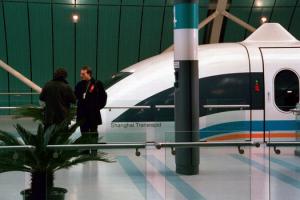|
As magnetic levitation (maglev) systems begin to come on line
around the world, questions surrounding these seemingly magical transportation technologies will naturally and inevitably
arise; especially, as the price of oil continues to climb. This board has been established to answer such questions and to
increase awareness of transportation engineering options, traffic congestion mitigation, and improved land development and
energy policies.
In March 2005 the 9 km/ 9 station HSST Tobu Kyuryo Line ( T K L )
opened in Nagoya , Aichi , Japan . Nicknamed " Linimo " , for " Linear motor car ", by May 2006 it had carried over 22 million with 99.997
% on-time reliability . Systems of the HSST type are proposed for Taipei, DaeJeon (opening 2007) , Beijing , Shanghai, and Johor Baru.
|
|
 |
|
Magnetic levitation is achieved in a variety of ways. What all these maglev systems share is the use of electro-magnetic
power to suspend vehicles above and away from their guideways (tracks) rather than using wheels; although some systems use
wheels for suspension at low speeds and while at rest.
By suspending vehicles away from their guideways, the friction
resulting from wheel on track contact is eliminated as an impediment to higher speeds. This same electro-magnetic power is
also used to propel vehicles, which also means they are not polluting their rights of way. The regular use of mechanical friction
brakes is also eliminated, along with the need for expensive brake maintenance.
All of these innovations result in much lower operational and maintenance expenditures, while also enabling
significantly higher speeds and faster rates of acceleration and deceleration.
Maglev systems are cost effective, quiet and energy efficient and fit seamlessly into the vision of developing
sustainable and livable pedestrian communities that enhance, rather than compromise, citizen mobility.
By : Dr Johannes Kluhspies.

|
 |
|
|
 |
|
|
|
